建筑工程专业英语unit6
- 格式:ppt
- 大小:908.00 KB
- 文档页数:19
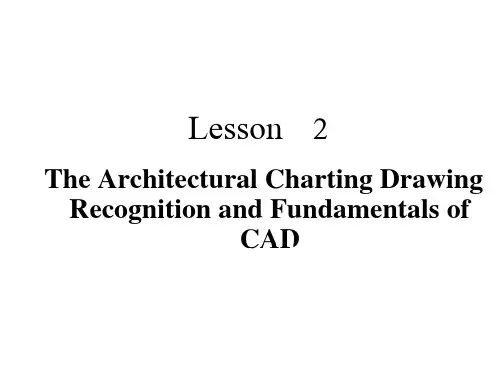

Unit 6 Give Me Liberty, or Give Me Death课文I翻译1. 议长先生:我比任何人更钦佩刚刚在议会上发言的先生们的爱国主义精神和才干。
但是,对同样的问题,智者见智,仁者见仁。
因此,尽管我的观点与他们大相径庭,但是我仍要把自己的心里话一吐为快,并希望不要因此而被看做是对他们大不敬:现在不是讲客套的时候。
摆在议会面前的问题关系到国家的存亡。
我认为,这是关系到享受自由还是蒙受奴役的关键问题,而且正因为事关重大,我们的辩论就要做到各抒己见。
只有这样,我们才能弄清事实的真相,才能不辜负上帝和祖国赋予我们的责任。
在这种时刻,如果怕得罪人而闭口不言,我认为就是叛国,就是比对世上所有国君更为神圣的上帝的不忠行为。
2. 议长先生,对希望抱有幻觉是人的天性。
我们往往紧闭双眼不去正视痛苦的现实,而是倾听海妖蛊惑人心的歌声,让她把我们变成禽兽。
在为自由而进行艰苦卓绝的斗争中,这难道是聪明人的所作所为吗?难道我们愿意为对获得拯救如此至关重要的事情视而不见,听而不闻吗?就我来说,无论精神上有多么痛苦,我仍愿意获悉全部的真相和最坏的事态,并为之做好充分准备。
3. 我只有一盏指路明灯,那就是经验之灯。
除了过去的经验,我没有其他的方法去判断未来。
依据过去的经验,我倒希望知道,十年来英国政府的所作所为,凭什么使得各位先生有理由满怀希望,并欣然用来安慰自己和议会呢?难道就是最近接受我们请愿时的那种狡诈的微笑吗?不要相信这种微笑,阁下,事实证明那是放置在您脚下的陷阱。
不要被人家的亲吻把自己出卖了!请你们扪心自问,接受我们请愿时的和蔼亲善与遍布海陆疆域的大规模备战怎么会相称呢?难道出于对我们的爱护和和解,就有必要动用战舰和军队吗?难道我们流露过绝不和解的愿望,因此结果为了重新赢得我们的爱,而必须诉诸武力吗?我们不要再欺骗自己了,阁下,这些都是战争和征服的工具,是国王们采取的最后的辩解手段。
4. 我要请问先生们,阁下,这些战争的部署如果不是为了迫使我们俯首称臣,那又意味着什么?先生们能够指出还有其他的动机吗?难道在世界的这个地方,还有什么敌人值得大不列颠如此兴师动众,调集如此庞大的海陆军队吗?没有了,阁下,什么敌人也没有。
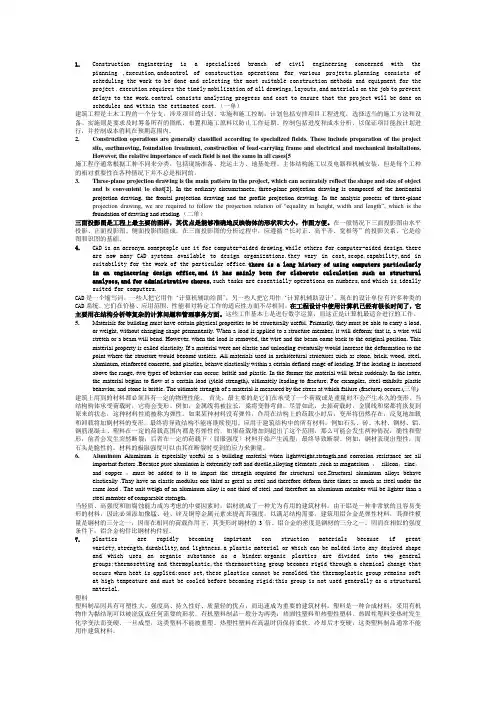
1.Construction engineering is a specialized branch of civil engineering concerned with thepianning ,execution,andcontrol of construction operations for various projects.planning consists of scheduling the work to be done and selecting the most suitable construction methods and equipment for the project .execution requires the timely mobilization of all drawings,layouts,and materials on the job to prevent delays to the work.control consists analyzing progress and cost to ensure that the project will be done on schedules and within the estimated cost.(一单)建筑工程是土木工程的一个分支,涉及项目的计划、实施和施工控制。
计划包括安排项目工程进度,选择适当的施工方法和设备。
实施则是要求及时筹备所有的图纸、布置和施工原料以防止工作延期。
控制包括进度和成本分析,以保证项目能按计划进行,并控制成本消耗在预期范围内。
2.Construction operations are generally classified according to specialized fields. These include preparation of the projectsite, earthmoving, foundation treatment, construction of load-carrying frame and electrical and mechanical installations.However, the relative importance of each field is not the same in all cases[5施工程序通常根据工种不同来分类,包括现场准备、挖运土方、地基处理、主体结构施工以及电器和机械安装,但是每个工种的相对重要性在各种情况下并不总是相同的。
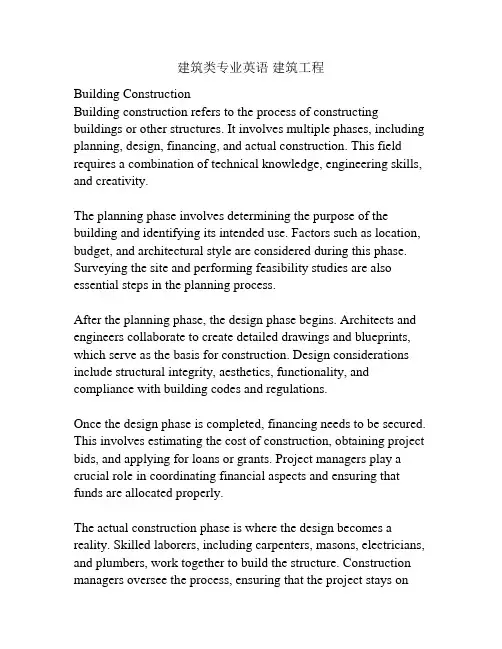
建筑类专业英语建筑工程Building ConstructionBuilding construction refers to the process of constructing buildings or other structures. It involves multiple phases, including planning, design, financing, and actual construction. This field requires a combination of technical knowledge, engineering skills, and creativity.The planning phase involves determining the purpose of the building and identifying its intended use. Factors such as location, budget, and architectural style are considered during this phase. Surveying the site and performing feasibility studies are also essential steps in the planning process.After the planning phase, the design phase begins. Architects and engineers collaborate to create detailed drawings and blueprints, which serve as the basis for construction. Design considerations include structural integrity, aesthetics, functionality, and compliance with building codes and regulations.Once the design phase is completed, financing needs to be secured. This involves estimating the cost of construction, obtaining project bids, and applying for loans or grants. Project managers play a crucial role in coordinating financial aspects and ensuring that funds are allocated properly.The actual construction phase is where the design becomes a reality. Skilled laborers, including carpenters, masons, electricians, and plumbers, work together to build the structure. Construction managers oversee the process, ensuring that the project stays onschedule and within budget. They also deal with issues such as safety compliance and quality control.Throughout the construction process, various materials and techniques are used. Building materials range from traditional options such as bricks, concrete, and steel to newer alternatives like sustainable materials and pre-fabricated components. Construction methods can vary depending on the project requirements and available technology.It is essential to ensure that building codes and regulations are followed during construction. These regulations are in place to ensure the safety and stability of the structure, as well as to address environmental concerns. Building inspectors play a critical role in inspecting and approving construction at various stages.Once construction is complete, the building undergoes a final inspection. If everything meets the required standards, a certificate of occupancy is issued, allowing the building to be occupied and used. Post-construction maintenance and repairs are also necessary to ensure the longevity and safety of the structure.In conclusion, building construction is a complex process that involves numerous stages and requires expertise from various professionals. From planning and design to actual construction and ongoing maintenance, careful attention to detail and adherence to regulations are crucial for successful building projects.。
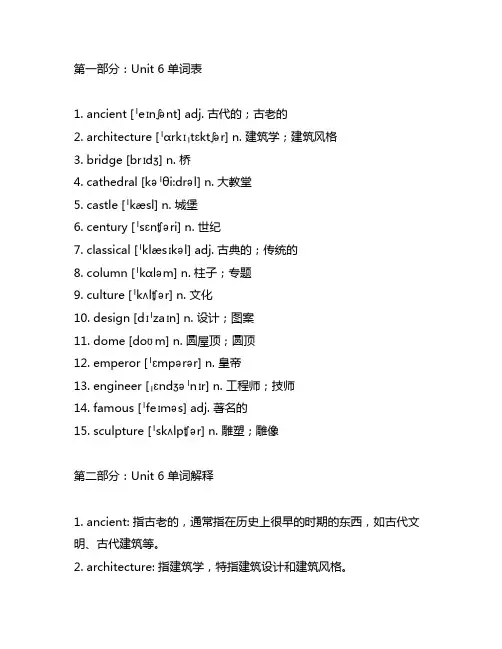
第一部分:Unit 6 单词表1. ancient [ˈeɪnʃənt] adj. 古代的;古老的2. architecture [ˈɑrkɪˌtɛktʃər] n. 建筑学;建筑风格3. bridge [brɪdʒ] n. 桥4. cathedral [kəˈθi:drəl] n. 大教堂5. castle [ˈkæsl] n. 城堡6. century [ˈsɛnʧəri] n. 世纪7. classical [ˈklæsɪkəl] adj. 古典的;传统的8. column [ˈkɑləm] n. 柱子;专题9. culture [ˈkʌlʧər] n. 文化10. design [dɪˈzaɪn] n. 设计;图案11. dome [doʊm] n. 圆屋顶;圆顶12. emperor [ˈɛmpərər] n. 皇帝13. engineer [ˌɛndʒəˈnɪr] n. 工程师;技师14. famous [ˈfeɪməs] adj. 著名的15. sculpture [ˈskʌlpʧər] n. 雕塑;雕像第二部分:Unit 6 单词解释1. ancient: 指古老的,通常指在历史上很早的时期的东西,如古代文明、古代建筑等。
2. architecture: 指建筑学,特指建筑设计和建筑风格。
3. bridge: 指桥,建筑物,用来连接两个地点,通常横跨河流或道路。
4. cathedral: 指大教堂,基督教的大型宗教建筑。
5. castle: 指城堡,一种古老的军事建筑,通常为贵族或国王所建。
6. century: 指世纪,指历法上的百年为一个单位。
7. classical: 指古典的,通常指某种艺术或文化形式,如古典音乐、古典文学等。
8. column: 指柱子,建筑物中用来支撑建筑物的纵向结构。
9. culture: 指文化,包括社会习俗、文学艺术、宗教信仰等。
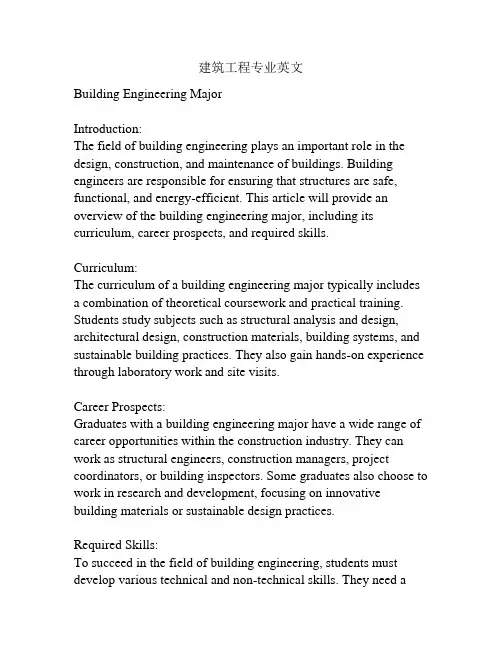
建筑工程专业英文Building Engineering MajorIntroduction:The field of building engineering plays an important role in the design, construction, and maintenance of buildings. Building engineers are responsible for ensuring that structures are safe, functional, and energy-efficient. This article will provide an overview of the building engineering major, including its curriculum, career prospects, and required skills.Curriculum:The curriculum of a building engineering major typically includes a combination of theoretical coursework and practical training. Students study subjects such as structural analysis and design, architectural design, construction materials, building systems, and sustainable building practices. They also gain hands-on experience through laboratory work and site visits.Career Prospects:Graduates with a building engineering major have a wide range of career opportunities within the construction industry. They can work as structural engineers, construction managers, project coordinators, or building inspectors. Some graduates also choose to work in research and development, focusing on innovative building materials or sustainable design practices.Required Skills:To succeed in the field of building engineering, students must develop various technical and non-technical skills. They need astrong understanding of mathematics, physics, and computer-aided design software. Good communication and problem-solving skills are also crucial, as building engineers often work in teams and need to collaborate with architects, contractors, and other professionals.Conclusion:The building engineering major provides students with the knowledge and skills necessary to contribute to the construction industry. Graduates can make significant contributions in areas such as structural design, project management, and sustainable building practices. By combining technical expertise with problem-solving and communication skills, building engineers play a vital role in creating safe, functional, and environmentally-friendly buildings.。
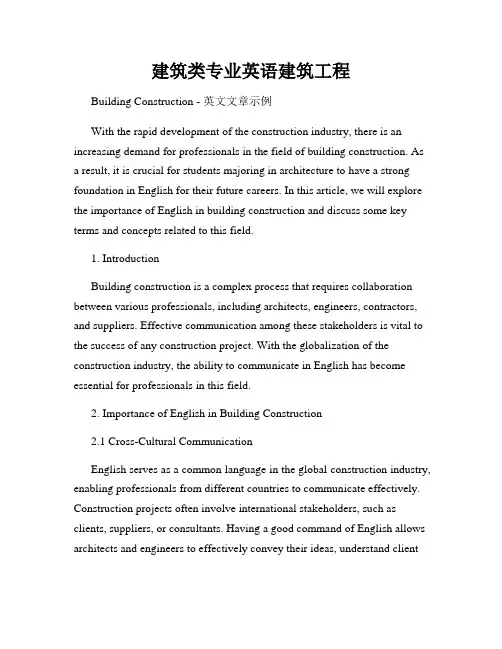
建筑类专业英语建筑工程Building Construction - 英文文章示例With the rapid development of the construction industry, there is an increasing demand for professionals in the field of building construction. As a result, it is crucial for students majoring in architecture to have a strong foundation in English for their future careers. In this article, we will explore the importance of English in building construction and discuss some key terms and concepts related to this field.1. IntroductionBuilding construction is a complex process that requires collaboration between various professionals, including architects, engineers, contractors, and suppliers. Effective communication among these stakeholders is vital to the success of any construction project. With the globalization of the construction industry, the ability to communicate in English has become essential for professionals in this field.2. Importance of English in Building Construction2.1 Cross-Cultural CommunicationEnglish serves as a common language in the global construction industry, enabling professionals from different countries to communicate effectively. Construction projects often involve international stakeholders, such as clients, suppliers, or consultants. Having a good command of English allows architects and engineers to effectively convey their ideas, understand clientrequirements, and collaborate with professionals from different cultural backgrounds.2.2 Access to International ResourcesEnglish is the primary language used in academic research and industry publications. Proficiency in English allows professionals in building construction to access a wealth of knowledge and stay updated with the latest developments in the field. It provides access to international building codes, standards, and regulations, enabling architects and engineers to ensure their designs comply with international best practices.3. Key Terms and Concepts3.1 Structural AnalysisStructural analysis is a fundamental aspect of building construction. It involves calculating the forces and stresses acting on a structure to ensure its stability and durability. English proficiency is crucial in understanding and applying the principles of structural analysis, as well as communicating the results to stakeholders.3.2 Building Information Modeling (BIM)BIM is a digital representation of a building, providing a collaborative platform for project stakeholders to share and store information throughout the construction process. Familiarity with English terminology related to BIM is essential for architects and engineers to effectively utilize BIM software and communicate with other professionals involved in the project.3.3 Construction ManagementConstruction management involves planning, coordinating, and controlling the construction process. English skills are necessary for professionals in this field to communicate with contractors, subcontractors, and workers on site. Clear and accurate communication is crucial to ensure that the project progresses smoothly and that any issues or delays are promptly addressed.4. ConclusionIn conclusion, English proficiency plays a significant role in the success of professionals in the field of building construction. It facilitates effective communication, enables access to international resources, and allows for the understanding and application of key terms and concepts in the industry. As the construction industry continues to grow and become more global, mastering English is becoming increasingly important for students majoring in architecture and related fields. By investing in English language skills, future professionals can enhance their career prospects and contribute to the success of construction projects worldwide.。
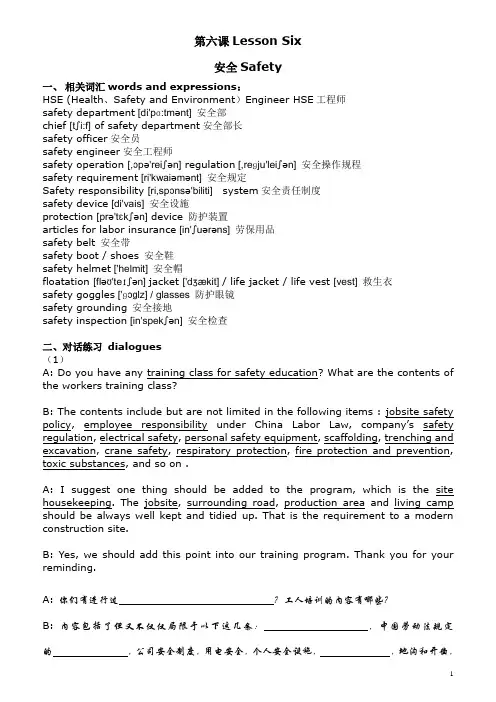
第六课Lesson Six安全Safety一、相关词汇words and expressions:HSE (Health、Safety and Environment)Engineer HSE工程师safety department [di'pɑ:tmənt] 安全部chief [tʃi:f] of safety department安全部长safety officer安全员safety engineer安全工程师safety operation [,ɔpə'reiʃən] regulation [,reɡju'leiʃən] 安全操作规程safety requirement [ri'kwaiəmənt] 安全规定Safety responsibility [ri,spɔnsə'biliti]system安全责任制度safety device [di'vais] 安全设施protection [prə'tɛkʃən] device 防护装置articles for labor insurance [in'ʃuərəns] 劳保用品safety belt 安全带safety boot / shoes 安全鞋safety helmet ['helmit] 安全帽floatation [fləʊ'teɪʃən] jacket ['dʒækit] / life jacket / life vest [vest] 救生衣safety goggles ['ɡɔɡlz] / glasses 防护眼镜safety grounding 安全接地safety inspection [in'spekʃən] 安全检查二、对话练习dialogues(1)A: Do you have any training class for safety education? What are the contents of the workers training class?B: The contents include but are not limited in the following items : jobsite safety policy, employee responsibility under China Labor Law, company’s safety regulation, electrical safety, personal safety equipment, scaffolding, trenching and excavation, crane safety, respiratory protection, fire protection and prevention, toxic substances, and so on .A: I suggest one thing should be added to the program, which is the site housekeeping. The jobsite, surrounding road, production area and living camp should be always well kept and tidied up. That is the requirement to a modern construction site.B: Yes, we should add this point into our training program. Thank you for your reminding.A: 你们有进行过?工人培训的内容有哪些?B: 内容包括了但又不仅仅局限于以下这几条:,中国劳动法规定的,公司安全制度,用电安全,个人安全设施,,地沟和开凿,起重机安全,呼吸器官保护,防火和救护,等等。
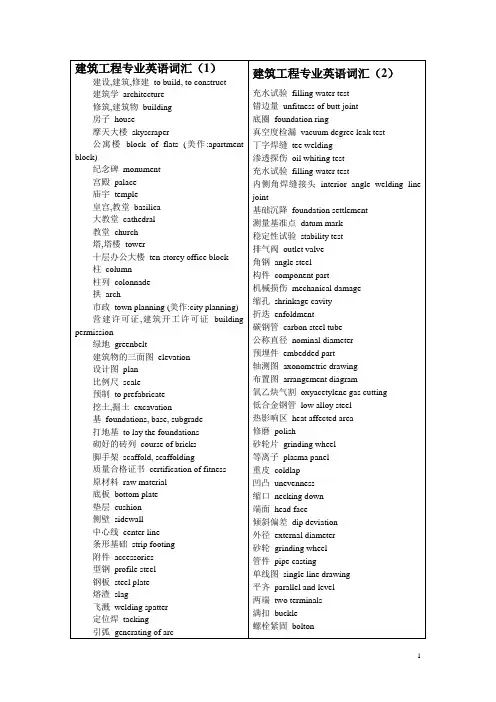
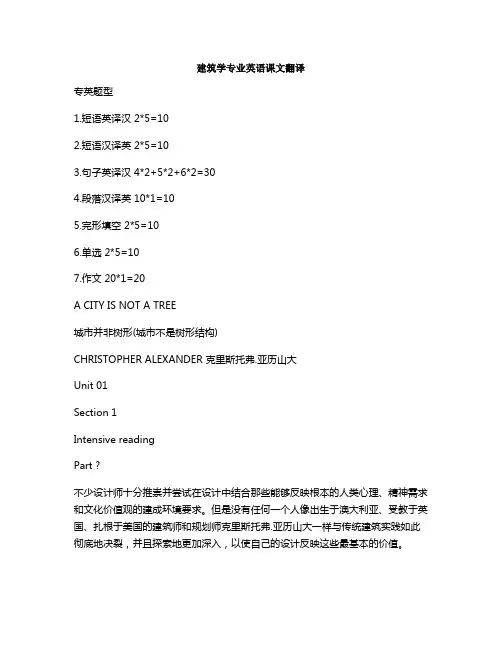
建筑学专业英语课文翻译专英题型1.短语英译汉 2*5=102.短语汉译英 2*5=103.句子英译汉 4*2+5*2+6*2=304.段落汉译英 10*1=105.完形填空 2*5=106.单选 2*5=107.作文 20*1=20A CITY IS NOT A TREE城市并非树形(城市不是树形结构)CHRISTOPHER ALEXANDER 克里斯托弗.亚历山大Unit 01Section 1Intensive readingPart ?不少设计师十分推崇并尝试在设计中结合那些能够反映根本的人类心理、精神需求和文化价值观的建成环境要求。
但是没有任何一个人像出生于澳大利亚、受教于英国、扎根于美国的建筑师和规划师克里斯托弗.亚历山大一样与传统建筑实践如此彻底地决裂,并且探索地更加深入,以使自己的设计反映这些最基本的价值。
亚历山大自称是一个破坏偶像(反对传统观念)的人,他有意识地同二十世纪建筑学和城市规划的主流思想保持距离。
值得注意的是:他挑出来在下文中进行攻击的8个“树形”规划是二十世纪最受尊重、最富盛名的规划方案的代表,包括勒.柯布西耶基于其建造一个现代城市的理论而为印度昌迪加尔新区做的规划;还包括保罗. 索莱尔的位于亚利桑那沙漠中梅萨市的空想巨型结构。
自从他最早发表挑衅性的观点攻击后面所选的正规的“树形”城市规划内容贫乏以来,亚历山大一生都从事于探求解读潜藏在人类需求下的深层结构体系以及对建筑新样式的再生模式的定义。
下面所选例子清楚地说明,一个城市不应该设计成像整洁的树形分枝组织那样把各个功能彼此分开。
亚历山大谴责整洁的城市规划,它们把“邻里”用界限分离,划分一个区域用作居住另一个用作商业,或者专门创建一个区域用作大学或文化设施。
他认为人类活动远比那些更为复杂和交叠。
亚历山大在文章节选中提出的城市设计策略可能会困扰那些寻求清晰、理性设计准则的人们。
亚历山大的观点是:关于如何设计非树状结构的城市还所知不够,从而无法提出明确的解决方案。

建筑工程专业英语词汇(1)建设建筑,修建to build, to con struct 建筑学architecture 修筑,建筑物buildi ng 房子house 摩天大楼skyscraper 公寓楼block of flats (美作:apartment block)纪念碑monument 宫殿palace 庙宇temple皇宫,教堂basilica 大教堂cathedral 教堂church 塔塔楼tower 十层办公大楼ten-storey office block柱column 柱列colonnade 拱arch 市政town planning (美作:city planning)营建许可证,建筑开工许可证buildi ng permissi on绿地greenbelt 建筑物的三面图elevati on设计图plan 比例尺scale 预制toprefabricate 挖土,掘土excavation 基foundations, base, subgrade 打地基to laythe foundations 砌好的砖歹U course ofbricks 脚手架scaffold, scaffolding 质量合格证书certificatio n of fitn ess原材料raw material 底板bottom plate 垫层cushion 侧壁sidewall 中心线center line 条形基础strip foot ing 附件accessories 型辛钢profile steel 钢板steel plate 熔渣slag 飞溅welding spatter 定位焊tacking 弓丨耳弧generating of arc 建筑工程专业英语词汇(2)充水试验filli ng water test 错边量unfitness of butt joint 底圈foundation ring 真空度检漏vacuum degree leak test 丁字焊缝tee welding 渗透探伤oil whiti ng test 充水试验filli ng water test 内侧角焊缝接头interior angle welding line joi nt 基础沉降foundation settlement 测量基准点datum mark 稳定性试验stability test 排气阀outlet valve 角钢angle steel 构件component part 机械损伤mecha ni cal damage 缩孑L shrinkage cavity 折迭enfoldment 碳钢管carb on steel tube 公称直径nominal diameter 预埋件embedded part 轴测图axonometric drawing 布置图arrangement diagram 氧乙炔气割oxyacetyle ne gas cutt ing 低合金钢管low alloy steel 热影响区heat affected area 修磨polish 砂轮片grinding wheel 等离子plasma panel 重皮coldlap 凹凸unevenness 缩口necking down 端面head face 倾斜偏差dip deviation 夕卜径external diameter 砂轮grinding wheel 管件pipe casting 单线图single line drawing 平齐parallel and level 两端two terminals 满扣buckle 螺栓紧固bolt on熄弧quenching of arc 焊道welding bead 坡口beveled edges 夕卜观检查visual in spect ion 重皮double-skin 水平方向弧度radia n in horiz on tai directio n成型molding直线度straightness accuracy 焊缝角变形welding line angular distortio n水平度levelness 铅垂度verticality 翘曲变形buckli ng deformation 角尺angle square 对接焊缝butt weld 母材pare nt metal 法兰密圭寸面flange seali ng surface夹层in terlayer 表面锈蚀浓度surface corrosion concen trati on挠曲变bending deformation 超声波探伤ultrasonic testing/ ultrasonic exam in ati on压力容器pressure vessel 预制下料prefabricati on bait ing 排版直径set-typediameter 焊缝welding line 中幅板centerplate 测量方法measuri ng method 基准点datum mark 跳焊skip welding 允许偏差allowable variati on 补强板stiffening plate开孑L tapping对接接头banjo fixing butt jointing 角钢angle iron安装基准圆in stallati on fun dame ntal circle吊装立柱hoisti ng upright colu mn 焊接钢管welded steel pipe 向心斜拉筋cen tripetalcanting pull rope带板band plate 槽钢胀圈cha nnel steelexpa nsion ring 环口collar extension 局部变形local distortion 周边periphery 附加应力additio nal stress 同轴度axiality 平行度parallelism 随机stochastic 允许偏差allowable variati on 重直度verticality 水平度levelness 隔离盲板bli nd plate 氩弧焊argon arc welding 压盖螺栓gla nd bolt 间距spaci ng 有效期period of validity 担任take charge of undertake 焊条welding rod 碳钢焊条carbon steel 焊丝welding wire 熔化焊melting 钢丝steel wire 气体保护焊gas shielded arc weldi ng 烘干drying 清洗ablution 制度s ystem 焊接工艺weld ing procedure 相应corresponding 手工电弧焊manual electric arc weldi ng 手工钨极man ual tun gste n electrode 打底render 电源power source 交流alternating current 焊件weldment 管壁厚度pipe thick ness 对接焊缝butt weld 工件壁厚workpiece 飞溅物splash 沾污smirch 油污oil stain 细锉smooth file 铳刀milling cutter 氧化膜oxide film 脱脂处理un grease treatme nt] 棉质纤维cotton fibre 丙酮acet one 硫sulfur环缝circumferential weld顶板top plate 拱顶vault 顶板加强肋stiffening rib 对接butt joint 胎具clamping fixture卷板机plate bending rolls 中心支架cen terbeari ng bracket 椭圆度ovality 等分线bisectrix 搭接宽度lap width 点焊spotwelding 搭接焊overlap welding 对称symmetrically 螺旋爬梯cockle stairs 放料阀baiting valve 液位计content gauge 芬兰维萨拉Vailsla OY 美国美科"Met-coil, USA" 集中式空调系统centralized air con diti oning system裙房annex 热源heat source 平面位置的空间space of planimetric positi on密圭寸性能seali ng performa nee机房machine room 节点timing专业"profession or discipline 都可以,要根据上下文”连体法兰coupli ng flange 垂直井笼verticalwell cage 变风量variable air rate 施工面展开con struct ion un folds 违约行为non complia nee合同交底-contract presentation 管理承包商Manageme nt Con tractor party工程量work amount实施的形象进度progress of impleme ntation完工资料as-built docume ntatio n文整clear-up 审核review 汽车式起重机Autocra ne 深化图纸deepe n draw ing焊齐U welding flux 钢板steel plate 纵向焊缝Iongitudi nal weld Ion gitudi nal seam 筒节shell ring 圭寸头end socket 卷管reelpipe 强度试验stre ngth test 起弧arc starting 穿堂风draught 熔合fusion 反面reverse side 整体integral 圭寸堵block up 焊口weld bond 医用胶布medical proof fabric 高频high frequency 焊炬welding torch建筑工程专业英语词汇翻译(4)综合分析判断comprehensive analysis and judgeme nt变压器transformer 扌由芯loose core 过道aisle三相电容three phase capacitanee 芯棒core rod都市规划与土地开发Urban g and Land Developme nt社区开发及工业区开发Community Development and Industry Park Developme nt开发许可申请Developme nt Permit土地使用变更计划La nd Use Rezo ning Pla n 主要计划及细部计划Master Plan and Detail Pla n都市计划更新计划Urban Ren ewal Pla n都市设施Urban Desig n 建筑设施Architecture Desig n 大地工程Geotech ni cal Engin eeri ng 工址调查Site In vestigati on 现地试验与室内试验In-Situ and Laboratory Test 基础工程Foun dati on Desig n设备配置计戈U equipment furnishment pla n结构预埋配合阶段Structure pre-embedme nt assista neestage精装修阶段Fi ne fitme nt stage 工程施工阶段Con struct ion stage 工程竣工阶段Completio n stage 台钻Bench drill 冲击钻Churn drill手电钻Electric portable drill 砂轮切割机Abrasive cutt ing off mach ine 角钢卷圆机An gle iron rolli ng mach ine 管道切断器Pipe cutt ing mach ine 铜管调直机Copperpipe straighteningmach ine管道压槽机Book joint setting machine for pipes管道压槽机Book joint setting machine for pipes角向磨光机An gle polishi ng mach ine 电动套丝机Electric threadi ng mach ine 电动卷扬机Electric winch电动试压泵Motor-drive n pressure test pump手动试压泵Manual pressure test pump 阀门试压机Valve pressure test device 阀门试压机Valve pressure test device TDC(F)风管加工流水线TDC(F)air ductwork fabricati onstream line等离子切割机Plasma cutt ing mach ine TDC(F)法兰条成型机TDC(F) flange strip shap ing mill勾码成型机Forming machine for flange clampTDC(F)风管加工成型机TDC(F) duct fabrication shaping mill多普勒超声波流量检测仪Doppler ultras onic flow detector温、湿度传感器"Temperature, humidity sen or"精密声级计Precisi on sound level meter 风管漏风量测试仪、风室式漏风测试装置"Duct airleakagetester, airchamber air leakage testing深开挖工程及建物保护Deep Excavation and Building Protection新生地及软弱地层改良Reclamation and Soft Ground Improveme nt山坡地开发与水土保持Slope land Developme nt, Soil and Water Con servati on 潜盾隧道与岩石隧道Shield Tunnel and RockTu nnel大地工程施工顾问Geotech nical Co nstructio n Con sulta nt土壤材料试验Soil and Material结构工程Structural Engin eeri ng 各类钢筋混凝土、预力混凝土、钢结构及钢骨钢筋混凝土结构Structures of R.C.,Prestressed Con crete, Steel, and SRC 桥梁、高层建筑、地下结构物、隧道、深开挖挡土结构Bridges, High-Rise Buildings, Underground Structures, Tunnels, Retaining Structures for Deep Excavatio ns桥梁安全检测、评估及维修补强BridgeIn spect ion, Assessme nt, and Rehabilitati on 钢结构细部设计及制造图Steel Structural Detail Desig n and Shop Draw ings 厂房工程In dustrial Pla nt工业厂房-石化工厂、钢厂、电厂、气体厂、科技工业厂房、一般性厂房In dustrialPlants--Petroleum and Chemical, Steel, Power, Gas, High-Tech nical and Gen eral Pla nts 环保设施工厂-垃圾焚化厂、垃圾掩埋场、污水处理厂及相关管线Environment Protecting Plants--Incineration Plants, Garbage Disposal Plants, Waste Water Treatment Plants and Pipi ng System设备支撑结构、管架、操作平台Equipme nt Supporting Structures, Pipe Racks, Operating Platforms设备基础Equipme nt Foun dati ons 厂区一般土木及公共设施Ge neral Civil Works and Utilities of Pla nts运输工程Tran sportati on Engin eeri ng 运输规戈U Transportation Planning停车场设施工程规划、设计Engineering Planning & Desig n for Parking Facilities建筑交通维持计划Traffic Co ntrol &device"风卓式风量测试仪Air hood air rate tester微压计、毕托管、热球(电)风速仪"Microma no meter ,pitot tube, hot bulb (electrical)an emoscope"潜水泵Submerged pump 电动弯管机Electric pipe ben der 铜管弯管机Copper pipe ben der 液压弯管机Hydraulic pipe ben der 电动剪刀Electric clipper 液压铆钉钳Hydraulic rivet ing clamp 线槽电锯Trunking electric saw 开孑L器Tapper 电动空压机Electric air compressor 液压千斤顶Hydraulic jack 液压手推车Hydraulic trolley 焊条烘干箱Weldi ng rod dryi ng box 手拉胡户Chai n block 道(垫)木Sleeper 转速表Tachometer 电流钳型表Clip-style ammeter 压力表Pressure gauge 接地电阻测试仪Earth ing resista nee testi ng device氧气表Oxygen gauge 乙炔表Acetylene gauge 对讲机Walkie talkie 文件和资料docume nts and in formati on? 建设单位Con struct ion un it 安装单位In stallation unitz 建筑工程专业英语词汇翻译(3)送气air supply 电流衰减装置curre nt atte nu ati on 气体延时保护装置time delay熄弧quenching of arc 成型molding 钢印代号steel seal 质量分析quality an alysis 负责人principal 审批examine and approve 补焊工艺repair weldi ng 压缩机compression pump 平焊法兰welded flan ge 测试流程图test flow chart Man ageme nt duri ng Con struct ion水利及港湾工程Hydraulic and Harbor Engin eeri ng营建管理Con struct ion Man ageme nt估价及工程预算制作Estimates and Engin eeri ng Budget Works营建管理Con struct ion Man ageme nt 工程监造Con struct ion Supervisi on 施工计划Con struction Pla n 工程进度控管Schedule Control during Con struct ion施工规戈U Con struct ion Specificati ons 环境工程En viro nmen tal Engin eeri ng 环境影响评估Environment ImpactAssessme nt环境监测En viro nmen tal Mon itori ng地下水监测系统Grou ndwater Mon itori ng污水处理厂Wastewater Treatme nt Pla nt 污水下水道Sewage System 噪音振动防治Noise and Vibratio n垃圾焚化厂兴建工程Waste Incin erator废弃物处理系统工程Waste Treatment & Disposal共同管道Com mon Ducts管道及附属设施之规划设计Planning and Design of Common Ducts Structures and Subsidiary Facilities经济效益分析Economic and Efficiency An alysis财务评估Fi nan cial Evaluation 管理维护办法及组织订定Regulation for the Man ageme nt. Maintenance and Orga ni zati on电力复合脂electric force compo un ded grease 电缆敷设cable layi ng 电缆槽架cable channel主干线trunk line 弯头angle fitting 录9落处exfoliation 银粉aluminum powder 支持点support point 拆装disassembly and assembly 畅通smooth 电压等级electric pressure 通断实验on off加固措施rei nforceme nt measure 校验verify 升压boost pressure 读数off scale reading 满刻度值full-scale value 盲板blind plate 压力表pressure meter 强度intensity 目测eye survey, visiual inspection 半径radius 公式formula 管路pipeline 严密性leakproofness 导电膏conductive paste 压接compression joint 地上连接overgr ound 埋深buried depth 接地线earth wire 说明description 分线盒junction box 接地装置earth ing deivce 交叉across 塑料保护管protection tube 塑料带plastic tape 防腐处理preservative treatme nt 接地极earthing pole 接地电阻测试earth resista nee 防雷接地light ning protect ion 遵守comply with 避雷网light ning conduction 引下线down lead 搭接焊overlap welding 避雷针lightning rod 镀锌制品zinc coat ing 断接卡break ing of con tact 电阻resista nee 配电装置power distribution equipment 集中接地装置cen tralized串联cascade connection 干线联接main line 并歹U paratactic 单独solely 机组machine set 终端头terminals 余度remaining 标记牌notice plate 表册statistical forms 电缆桥架cable test ing bridge 电机electric machine 相对湿度relative humidity 杂物sun dries 耐压试验withstand voltage test 照明器具ligth ing parapher nalia 铭牌nameplate 验收规范accepta nee specificati on 接线wire splice 试运test run 进线口incoming line 带电electrified 盘车转子jigger rotor 二次回路sec ondary circuit 中心线center line 触头contactor 配电power distribution 成套whole set 楼板floor slab 备件duplicate part, spare part 包装packing 器材equipment 导线con duct ing wire 脱落fall off 规范specification 电器electrical applianee 断路器line breaker 机械联锁mecha ni cal in terlock ing 碰撞collision 轻便portable。
建筑英语unit6Unit 6 Chinese ArchitectureText ANew words:●Axis n. 轴,轴线—— an imaginary line through the centre of an object, around which theobject turn.●Position v. 安放,安置——to put sb/sth in a particular position.●Ethnical a. 种族的——connected with or belonging to a nation, race or tribe that shares acultural tradition.●Neolithic a. 新⽯器时代的——of the later part of the STONE AGE.●Antisepsis n. 防腐(法),抗菌(法)——a substance that helps to prevent infection in woodsby killing bacteria.●Feudal a. 封建(制度)的——connected with or similar to feudalism.●Deem v. 认为——to have a particular opinion about sth.●Phoenix n. 凤凰——a mythical bird, the only one of its kind, that after living for five or sixcenturies in the Arabian desert, burnt itself on a funeral pyre and rose from the ashes with renewed youth to live through another cycle.●Foil n. 箔,⾦属薄⽚——metal made into very thin sheets that is used for covering orwrapping things.●Hallmark n. 标志,特点——a feature or quality that is typical of sb/sth.●Cluster n. 串,丛,簇——a group of things of the same type that grow or appear closetogether.●Buddhist a. 佛教的——an Asian religion based on the teaching of Buddha.●Ward off 避开,挡开——to protect or defend yourself against danger ,illness, attack,etc.●Mythical a. 神话的——that does not exist or is not true.(connected with ancient MYTHS.)●Vegetation n. 植被——plants in general, especially the plants that are found in a particulararea or environment.●Trinity n. 三位⼀体,三合⼀——(in Christianity)the union of Father, Son andHOL Y SPIRIT as one God.●Repulse v. 击退,驱逐——to fight sb who is attacking you and drive them away.●Cohabitation n. 共⽣,共同存在——to live together.●Occult a. 超⾃然的,神秘的——connected with magic powers and things that cannot beexplained by reason or science.Architectural terms:●Bonding n. 接,接合——the process of forming a relationship with sth.●Joist n. 托梁——a long thick piece of wood or metal that is used to support a floor or ceilingin a building.●Overhanging a. 突出的——to stick out over and above sth else.●Tier building 多层建筑——a row or layer of sth that has several rows or layers placed oneabove the building.●Bracket n. 托架,⽀架,⽃拱——a piece of wood, metal or plastic fixed to the wall tosupport a shelf, lamp, etc.●Glazed tiling 釉⾯砖,琉璃⽡——a thin clear liquid put on clay objects before they arefinished, to give them a hard shiny surface.●Spirit gate 神门Proper names:●Tang Dynasty 唐朝——(618 -907)was an imperial dynasty of China preceded by the SuiDynasty and followed by the Five Dynasties and Ten Kingdoms Period.●Vietnam 越南——is the easternmost country on the Indochina Peninsula in Southeast Asia.It is bordered by People's Republic of China (PRC) to the north.●Shang Dynasty 商朝——(1766 -1122 BC)was according to traditional sources the secondChinese dynasty, after the Xia Dynasty. They ruled in the northeastern regions of the area known as ―China proper‖ in the Yellow River valley.●Zhou Dynasty 周朝——(1046–256 BC) followed the Shang Dynasty and was followed bythe Qin Dynasty in China. The Zhou dynasty lasted longer than any other dynasty in Chinese history.●Han Dynasty 汉朝——(206 – 220 BC) was the second imperial dynasty of China, precededby the Qin Dynasty. It was founded by the peasant rebel leader Liu Bang, known posthumously as Emperor Gaozu of Han. Text BNew words:●Embrace v. 包含——to comprise or include as an integral part.●Veritable a. 真正的,名副其实的——genuine or true。
新编建筑工程专业英语Building Engineering Major: A Fresh Perspective on Construction and TechnologyIntroduction:The field of building engineering is an essential sector in the construction industry, combining the principles of civil engineering and architecture. It focuses on the design, construction, and maintenance of various structures, ensuring their safety, functionality, and efficiency. This article aims to provide a unique and comprehensive overview of building engineering, including the latest advancements and challenges in this dynamic field.1. The Role of Building Engineering in the Construction Industry: Building engineering plays a crucial role in shaping the built environment. It incorporates scientific principles, innovative design strategies, and cutting-edge technologies to create sustainable and aesthetically pleasing structures. The responsibility of a building engineer extends from initial planning and design to the overall management of construction projects.2. Fundamental Principles and Techniques in Building Engineering: Building engineers employ a range of skills and techniques to ensure the successful completion of construction projects. This includes knowledge of structural analysis, construction materials, mechanical systems, and electrical installations. They also utilize computer-aided design (CAD) software to create detailed models and conduct simulations to optimize building performance.3. Green Building and Sustainability:With growing concerns about environmental impact, building engineers are increasingly focusing on green building practices. They work towards energy efficiency, waste reduction, and the use of sustainable materials. Incorporating renewable energy systems, such as solar panels and geothermal heating, has become a standard practice in modern construction projects.4. Technological Advancements in Building Engineering:The advent of technology has revolutionized the field of building engineering. Building Information Modeling (BIM) software allows engineers to create virtual representations of structures, enabling efficient collaboration between different professionals involved in the construction process. Moreover, Internet of Things (IoT) devices, such as sensors and smart monitoring systems, offer real-time data on a building's performance, allowing for quick identification and resolution of issues.5. Challenges and Future Directions:Building engineering faces challenges such as adapting to rapid urbanization, climate change, and the integration of smart technologies. Moreover, the industry needs to address the shortage of skilled professionals and ensure continuous professional development for existing practitioners. As the world evolves, building engineers must remain proactive in embracing innovative solutions and sustainable practices.Conclusion:As the construction industry evolves, building engineering plays a pivotal role in creating safe, efficient, and sustainable structures. By combining scientific knowledge with technologicaladvancements, building engineers contribute to the development of the built environment. It is an exciting field that offers numerous opportunities for professionals to make a lasting impact on society's infrastructure.。